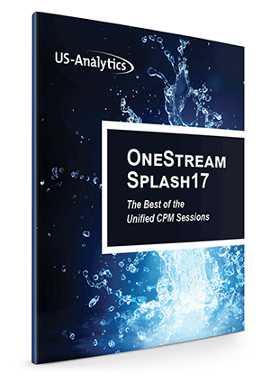One of the perks that comes with choosing OneStream as a CPM platform is the growing number of free out-of-the-box solutions available for licensed customers within the OneStream MarketPlace. One of those solutions is People Planning.
People Planning allows you to plan for employee and contractor compensations, benefits, as well as travel and expenses. The solution gives you flexibility based on dashboards and SQL tables.
In this blog post, you’ll learn everything you need to know about People Planning with OneStream, including:
- Why you should use People Planning
- How to implement People Planning
- Security with People Planning
- Tips and tricks
Why Use People Planning?
With this solution, you’re given better visibility into employee information with details on easy-to-read, flexible dashboards. The solution makes your employee data easier to manage with no need to update the cube with every new employee or metadata change. You get the ability to calculate additional employee or contractor information, including complex comp, benefit, or sales plans without costly downtime experienced with other products. People Planning is also tied to the expense budgeting solutions with drill-down capability from the appropriate ledger accounts.
The People Planning solution is designed with XF Relational Blending and operates under the assumption that People Planning is often planning for the unknown with many different managers and differing employee types. In other systems, all data must be fed into a cube and forces separate applications to contain outlines to represent unknown changes in their cube. This data simply does not belong in the cube. Relational Blending allows the data to live where it belongs with detailed transactional data that lives in relational tables.
This relational and cube data are still in a single application — delivering the best of both the worlds. Because the relational table lives together with the analytic model in this single application, you can always report and drill back to the details whenever you need to — giving you complete visibility into the details that make up the plan.
Additionally, all of your information is secure with controlled access through the record management dashboard to the People Planning Register. Source data is also restricted by the OneStream Data Connector.
Implementing People Planning
When you’re designing your solution, you’ll need to look at individual employee detail information vs. application (GL data) level needs. You should ask yourself:
- What information will be captured at the employee level?
- What does not need to be captured at the employee level?
- What information will be captured at the contractor level?
- What does not need to be captured at the contractor level?
- What data will be integrated?
- How are the employee details updated or planned?
Next, you need to decide how details are collected. You have two options
- HR Load (one or multiple sources or files; number of fields required, etc.)
- Derived (From HR Load): How? (FITE = 1 IF ‘FT’ value; .5 IF ‘PT value, etc.)
You also need to consider your performance by looking at how many employees and how many different types of employees will be contained within the system.
With People Planning, workflow will drive your process. You’ll have a Central Workflow Profile and an Individual Workflow Profiles. Both of these include a workspace channel to access the People Register and an import channel to load data from the People Planning tables into the OneStream XF Cube. The difference is the Central Workflow Profile includes a Central Load Connector, while the Individual Workflow Profiles include a Transfer IN Connector and Transfer OUT Connector.
How Does People Planning Security Work?
It’s incredibly important that your employee data is secure, something that OneStream fully understands. People Planning can be secured by individual end user and individual base level Entity. If you require less security, you can set your People Planning solution to be accessible and manageable by every user.
Optimizing People Planning
If you’ve already implemented People Planning with OneStream, the following tips can help you further optimize this solution.
Tip 1: Overall design
From an overall design standpoint, you should begin with your end goal in mind, asking yourself “What GL Accounts with OneStream XF will be driven from People Planning?” You should create a matrix listing all of the People Planning Solution Accounts, identifying each account:
- Source (HR Load, Derived, Calculated, Input)
- Logic (for Derived and Calculated values) such as burden accounts
- Integration details (PLP Account to GL Accounts: summaries, mappings, overrides, etc.)
- Notes and comments
- Security: who should access as well the type of access
Tip 2: People Planning accounts needed
You need to consider what People Planning accounts will be needed to drive the OneStream XF app accounts. To do this, you should create a list of all the salary and benefit accounts within your OneStream XF application. Create your list with the following information:
- Identifying each as in-scope or out-of-scope (this is for overall planning purposes)
- Associate each “in-scope” item with:
- Source (People Planning or OneStream XF Application)
- Logic (People Planning == Source Account; OneStream XF Application == business logic)
- Notes and comments
Tip 3: How transfer employees are handled in the system
Your Plan Data for transfer employees is visible via the Import process by the “receiving” entity during the load process from your People Planning solution to your OneStream XF Cube. The associated employee record is held at the transferring entity and never moved or visible to the “receiving” entity. To modify the data associated with that record, a new instance with the same Employee ID can be created with the “receiving” entity’s register — this is similar to the inherent process within the transferring entity’s register. The Employee ID associated with incoming data for the ‘Transfer In (PLP_PeoplePlanningData_EntityTIN)’ Import channels can be found by drilling back to the source data and viewing the Register detail provided.
Tip 4: Updates & migrations
Fortunately, no additional work is required with full migration of OneStream XF Applications. Application extracts include People Planning dashboards; however, this does not include SQL tables, and initial setup steps are required.
Your People Planning Dashboard File (TableSetup_PLPS.txt) will require an update that drives the table creation process and solution setup. This update does not contain Customer specific configuration, but it can be modified to recreate your Solution configuration through:
- People Planning tables that can be extracted to a file via a SQL Server Management Studio process
- Table information from SQL Studio that can be modified and used to update TableSetup_PLPS.txt. file.
Want to learn more about People Planning? Download the eBook for a deeper dive into OneStream!
– Terry Ledet
Terry Ledet is a seasoned financial systems professional, at US-Analytics, with expertise in developing complex financial reporting, accounting, and planning applications. With 18+ years of experience in project and resource management, Terry possesses the ability to identify and translate a client’s needs into an actionable technical solution.
Get Started With a Personal Demo





